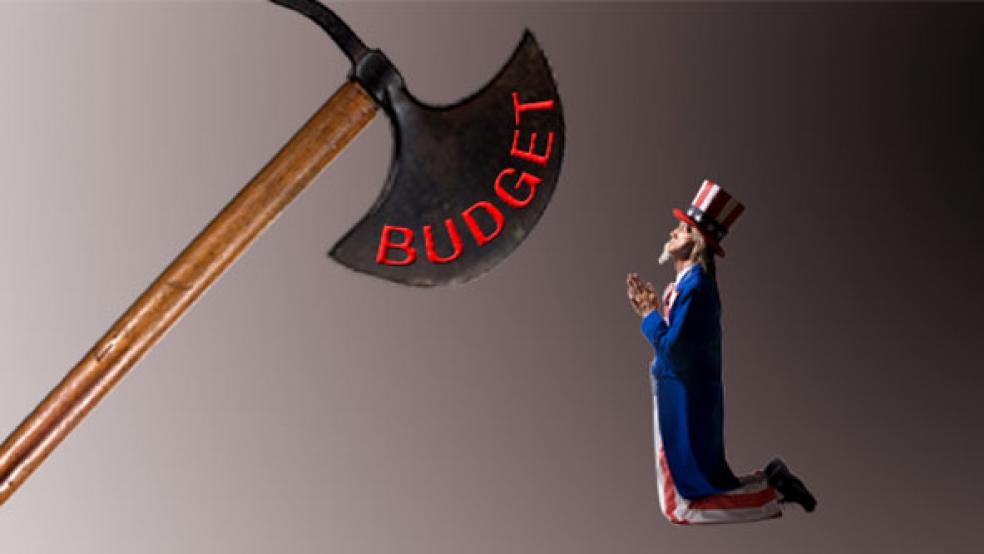One of the biggest problems we have in dealing with the budget is the gross level of budgetary ignorance on the part of the public that I detailed last week. But an even bigger problem is that Republicans in Congress appear to be just as ignorant about the actual impact of the grandiose spending cuts they repeatedly claim they are going to enact immediately. In coming weeks, everyone is going to get a very fast and very rough education on the real effects of slashing government spending.
On Feb. 9, House Appropriations Committee chairman Hal Rogers, R-KY, announced $74 billion in budget cuts in fiscal year 2011, which began on Oct. 1, 2010. Enacting large budget cuts in the current fiscal year when it’s almost half over is very foolish. Congress can’t cut spending that has already been spent, so it must cut very heavily from a small spending base to achieve meaningful savings.
Scott Lilly, who was staff director of the House Appropriations Committee, explains another problem. Because the Republicans are cutting the budget in such haste, many members, including those on the Appropriations Committee, really have no idea what is going on or what the effects of these cuts will be on people and programs. As Lilly explains:
“With many of the 93 freshmen members of the House still asking rudimentary budget questions such as: ‘what is the difference between an authorization and an appropriation?’ or ‘how do outlays differ from budget authority?’ the time frame that Rep. Rogers and his leadership are committed to means that not only will those voting on the proposal have little opportunity to understand it but the authors themselves will not have fully vetted or completely understood what they are proposing. There have been no hearings, no requests for testimony, and no opportunity even for staff charged with proposing the cuts to do agency-by-agency analysis of the possible negative consequences. Members will vote next week on the package without fundamental knowledge of how major budget changes in literally thousands of federal programs will impact the country in general or their own constituents in particular.”
In another commentary, Lilly explains how the meat-ax approach to budget cutting that Republicans have adopted would affect one agency, the Federal Bureau of Investigation:
“It has been operating at an annual rate of $7.8 billion since October. (The threat of a Senate filibuster in December forced Congress to abandon efforts to complete legislation that would have funded the president’s request to increase FBI funding to the level above $8 billion a year.) Since we will soon pass the halfway mark for the current fiscal year, the Bureau has already spent close to half its $7.8 billion. [House Budget Committee chairman Paul] Ryan's proposed cut of $44 billion applied across the board to all programs in the one-eighth of the budget subject to cuts would result in reducing FBI spending by almost $750 million, leaving it with less than $3.2 billion for operations for the remainder of the year — about 19 percent less than operated on for the first half of the year.”
The point is not that there are no government programs worthy of cutting, but rather that this is a really stupid way to do it. The vast bulk of government spending, which goes to mandatory programs such as Social Security and Medicare, is completely exempted. And Republicans have effectively exempted the departments of Defense, Homeland Security and Veterans Affairs from cuts. This leaves only 16 percent of the budget from which they will extract their pound of flesh to satisfy voters who demand huge budget cuts but also oppose cutting just about any program except foreign aid.
In coming weeks we could see a dramatic turnaround in public opinion on government spending. Up until now, it has all been theoretical; Republicans could easily pander to the Tea Party crowd with big promises of shrinking government without anyone in that crowd believing that it will affect them in any way.
But the fact is that millions of Americans benefit from government programs without realizing it. Indeed, research by Cornell political scientist Suzanne Mettler shows that many recipients of government benefits don’t believe that they have received any benefits. The following table shows the percentage of beneficiaries of various government programs who deny that they have in fact benefited from government social programs.
| Percentage of Program Beneficiaries Who Report They “Have Not Used a Government Social Program” | |
Program | “No, Have Not Used a Government Social Program” |
529 or Coverdell | 64.3 |
Home Mortgage Interest Deduction | 60.0 |
Hope or Lifetime Learning Tax Credit | 59.6 |
Student Loans | 53.3 |
Child and Dependent Care Tax Credit | 51.7 |
Earned Income Tax Credit | 47.1 |
Social Security—Retirement & Survivors | 44.1 |
Pell Grants | 43.1 |
Unemployment Insurance | 43.0 |
Veterans Benefits (other than G.I. Bill) | 41.7 |
G.I. Bill | 40.3 |
Medicare | 39.8 |
Head Start | 37.2 |
Social Security Disability | 28.7 |
Supplemental Security Income | 28.2 |
Medicaid | 27.8 |
Welfare/Public Assistance | 27.4 |
Government Subsidized Housing | 27.4 |
Food Stamps | 25.4 |
| Source: Suzanne Mettler, “Reconstituting the Submerged State: The Challenge of Social Policy Reform in the Obama Era,” Perspectives on Politics (September 2010): 809. | |
For this column, I tried to find some data on who benefits from various government programs. It turns out that the government doesn’t really know. The most comprehensive data appear in the Census Bureau’s Consolidated Federal Funds Report for Fiscal Year 2009, but the data is very aggregated and doesn’t tell much about how many people benefit from various programs or to what extent. In the most recent 2007 study, the Tax Foundation found that in 2004, a typical middle class family in the middle income quintile received $16,781 in benefits from the federal government.
No doubt, many of these people will very quickly find out who they are as soon as lobbyists start fighting the proposed cuts. Advertising, news stories, congressional testimony, and analyses from trade associations and think tanks will all be mobilized to identify, precisely, who will lose from the Republican meat ax and to make their views known. We could soon have a reverse Tea Party of laid off government workers, farmers and who knows how many other people irate at losing government benefits or government services such as post offices that will probably have to be closed.
We are already seeing some Tea Party favorites backtracking on their budget-cutting promises. For example, Rep. Michele Bachmann, R-MN, had promised to cut veterans benefits by $4.5 billion. But when veterans complained, she quickly took those cuts off the table. And on the House floor, Republican leaders have had difficulty getting the votes for their silly budget cut of the week plan.
It may turn out that the Republican effort is all for show and they won’t try very hard to make their cuts stick when Senate Democrats refuse to go along. Like their symbolic vote to repeal the Affordable Care Act, which has zero chance of enactment, it’s just a sop to their right-wing political base. When Republicans are unsuccessful, they will just demand more campaign contributions to elect more Republicans in 2012. Then, they will say, the real budget cutting will start. Unless, of course, Barack Obama is re-elected and they can’t get past his veto. Then Republicans will ask for still more money from their supporters to get veto-proof majorities in both the House and Senate. Then, they will say, the real budget cutting will begin. And so on, and so on.
The bottom line is that cutting spending is neither easy, nor simple, nor fast. Republicans may imagine that they are leading a Blitzkrieg against government, but the reality is that it is trench warfare. Every serious budget expert knows this. Republicans have been deluding their allies in the Tea Party movement with promises that they knew they couldn’t keep. Soon, everyone else will know, too.
Related Links
Federal Budget Battle: Can Congress Avoid a Government Shutdown? (Christian Science Monitor)
The Time for Spending Cuts is Now (The Wall Street Journal)






